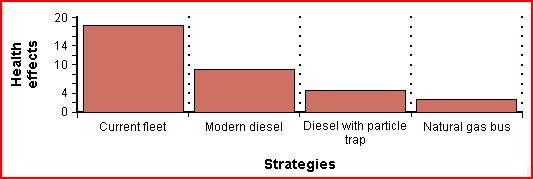Gasbus - health impacts of Helsinki bus traffic
| [show] |
|---|
This is the main page of the Gasbus assessment. The output of the group work exercise in Kuopio Risk Assessment Workshop 2008 will be collected on this page complemented with the indicator and other variable pages that will be created during the exercise.
Background material:
- An article about the assessment, published in Risk Analysis 2004, can be found here: Media:Tainio Gasbus RiskAnalysis 2004.pdf
- Download the model used in the assessment as an Analytica file from here: File:Gasbus model 01.ANA
- If you do not have Analytica installed in your computer, you can get a free trial of Analytica or a free Analytica player for viewing the model from Lumina Decision Systems website
Scope
Purpose
To compare PM2.5 induced mortality from currently available alternative public bus-transportation strategies as being considered by the Helsinki Metropolitan area.
Boundaries
- Area: Helsinki Metropolitan area, Finland
- Population: whole population in Helsinki area (1 million)
- Primary PM2.5
- Time period: Based on data 1996-1997, projected to year 2020
- Public Health effects: Mortality due to cardiopulmonary diseases, lung cancer and other non-accidental causes (?)
- Bus traffic tail-pipe emissions
Scenarios
- Business as usual (current bus fleet)
- All buses converted to modern diesel (EURO3-STD)
- All buses converted to diesel with particle traps
- All buses converted to natural gas buses
Intended users
- Helsinki Metropolitan area council
- Finnish government (e.g. Finnish ministry of social affairs and health)
- Scientific community
- Decision makers at local community level
Participants
- Moderator: Marko Tainio
- Scientists: KTL, YTV, Joint Research Centre @ European Commission
- Participants in Kuopio Risk Assessment Workshop 2008
Definition
Gasbus model in Analytica Web Player. Just click Launch model after the page has loaded.
Decision variables
Indicators
- The mortality due to PM 2.5 from buses
- Background mortality (for each health outcome)
Other variables
- Variable:PM2.5 emissions from bus traffic
- constant: Bus traffic intensity (if it remains the same)
- PM2.5 concentration from bus traffic in Helsinki in 2020
- data: total conc. of PM2.5 exposure in Helsinki
- Concentration-response to PM2.5
- Human behaviour (if data available) D↷
Indexes
Analyses
- Importance analysis
Result
Results
Conclusions
- Estimated excess mortality caused by the alternative bus fleets in 2020 in Helsinki Metropolitan Area varied between 3 and 18 deaths, indicating that levels of PM and the corresponding health effects can be affected to some extent by changing bus types.
- The difference in the excess mortality between natural gas buses and the presentdiesel engines with proper trapping systems is not large. Thus it is questionable whether the costs and alternative risks associated with the more complicated fuel storage and delivery systems for compressed natural gas would be covered by the marginal health benefits from the lower PM emissions.
- Emissions from buses in Helsinki are only a small fraction of the total traffic and other combustion particle emissions in the area and thus there are also possibilities for 14 acquiring similar or larger reductions in ambient PM concentrations and corresponding reductions in health effects.

